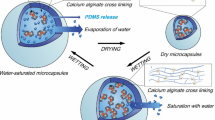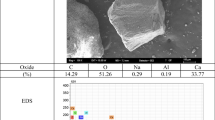Abstract
Field experience has shown that inadequate cuttings transportation and hole cleaning results in wellbore drilling challenges, such as pipe sticking, high torque and drag, low rate of penetration, formation damage, etc. Designing a drilling mud with optimum rheological properties would be crucial to improve cuttings transportation efficiency. Several studies have shown that drilling muds that combine polymers with silica nanoparticles (SiO2 NPs) to form polymer nanocomposite (PNC) can effectively modify the rheology and enhance the filtration properties of water-based muds (WBMs). Studies on the significant decrease of the yield point that may lead to a huge reduction in the transport capacity of drilled cuttings using polypropylene-silica nanocomposite (PSNC) have not been reported. In this study, the effect of surface charge of newly developed PSNC on rheological and filtration characteristics of WBMs were examined. The results from zeta potential measurements showed that the newly developed PSNC and bentonite particles are both negatively charged at different levels of pH, which would lead to decrease in the yield point of the PSNC bearing mud samples. This problem was resolved using (3-aminopropyl) triethoxysilane (APTES) to modify the surface of the newly developed PSNC. From the experimental results, the amino-modified PSNC showed better performance in controlling filtration and modifying rheology than the unmodified PSNC due to the electrostatic attraction between bentonite and modified PSNC. The concentration of 1.5 g of the modified PSNC has a significantly higher yield point of 16.0 lb/100 ft2 than the unmodified PSNC with 6.4 lb/100 ft2 at 78 °F; demonstrating its capacity to provide better cuttings transportation than the unmodified PSNC. The surface functionalization of the newly developed PSNC in WBMs showed promising results in the rheology and filtration properties which demonstrates the viability of using them in drilling operations.















Similar content being viewed by others
Abbreviations
- API:
-
American petroleum institute
- APTES:
-
(3-Aminopropyl) triethoxysilane
- EDX:
-
Energy dispersive X-ray
- FCT:
-
Filter cake thickness
- FESEM:
-
Field emission scanning electron microscopy
- FL:
-
Filtrate loss volume
- FTIR:
-
Fourier transform infrared spectroscopy
- GS:
-
Gel strength
- HLB:
-
Hydrophile-lipophile balance
- HPHT:
-
High pressure high temperature
- LPSA:
-
Laser particle size analyzer
- NP:
-
Nanoparticle
- PAC LV:
-
Low viscosity polyanionic cellulose
- PE-b-PEG:
-
Poly ethylene-block-poly(ethylene glycol)
- PNC:
-
Polymer nanocomposite
- PP:
-
Polypropylene
- PSD:
-
Particle size distribution
- PSNC:
-
Polypropylene-silica nanocomposite
- PV:
-
Plastic viscosity
- SiO2 NP:
-
Silica nanoparticle
- SiO2 :
-
Silica/silicon dioxide
- TEOS:
-
Tetraethyl orthosilicate
- TGA:
-
Thermal gravimetric analysis
- WBM:
-
Water-based mud
- YP:
-
Yield point
- ζ-potential:
-
Zeta potential
References
Abu-Jdayil B (2011) Rheology of sodium and calcium bentonite–water dispersions: effect of electrolytes and aging time. Int J Miner Process 98(3):208–213
Aftab A, Ismail AR, Ibupoto ZH, Zolkifile N (2017) Enhancing the rheological properties and shale inhibition behavior of water-based mud using nanosilica, multi-walled carbon nanotube, and graphene Nano platelet. Egypt J Pet 26(2):291–299
Agi A, Junin R, Gbadamosi A (2018) Mechanism governing nanoparticle flow behaviour in porous media: insight for enhanced oil recovery applications. Int Nano Lett 8:1–29
Akhtarmanesh S, Shahrabi MJA, Atashnezhad A (2013) Improvement of wellbore stability in shale using nanoparticles. J Pet Sci Eng 112(3):290–295
API recommended practice 13B-1 (2017) API standard practice for field testing water-based drilling fluids, 5th edn, pp 1–121
Barry MM et al (2015) Fluid filtration and rheological properties of nanoparticle additive and intercalated clay hybrid bentonite drilling fluids. J Pet Sci Eng 127:338–346
Bayat AE, Moghanloo PJ, Piroozian A, Rafati R (2018) Experimental investigation of rheological and filtration properties of water-based drilling fluids in presence of various nanoparticles. Colloids Surf A Physicochem Eng Asp 555:256–263
Boyou NV, Ismail I, Wan RWS, Amin SH, Husein N, Hui HT, Nadaraja K (2019) Experimental investigation of hole cleaning in directional drilling by using nano-enhanced water-based drilling fluids. J Pet Sci Eng 176:220–231
Caenn R, Darley HCH, Gray GR (2017) Introduction to drilling fluids. In: Composition and properties of drilling and completion fluids, 7th edn. Gulf Professional Publishing, USA, pp 1–748. ISBN: 978-0-12-804751-4
Chang G, He L, Zheng W, Pan A, Liu J, Li Y, Cao R (2013) Well-defined inorganic/organic nanocomposite by nano silica core-poly(methyl methacrylate/butylacrylate/trifluoroethyl methacrylate) shell. J Colloid Interface Sci 396:129–137
Chilingarian GV, Alp E, Caenn R, Al-Salem M, Uslu S, Gonzales S, Dorovi RJ, Marthur RM, Yen TF (1986) Drilling fluid evaluation using yield point-plastic viscosity correlation. Energy Sour 8(2–3):233–244. https://doi.org/10.1080/00908318608946052
Elochukwu H, Gholami R, Dol SS (2017) An approach to improve the cuttings carrying capacity of nanosilica based muds. J Pet Sci Eng 52:10–216
Gbadamosi AO, Junin R, Abdalla Y, Agi A, Oseh JO (2018a) Experimental investigation of the effects of silica nanoparticle on hole cleaning efficiency of water-based drilling mud. J Pet Sci Eng 172:26–1230
Gbadamosi AO, Junin R, Manan MA, Yekeen N, Agi A, Oseh JO (2018b) Recent advances and prospects in polymeric nanofluids application for enhanced oil recovery. J Ind Eng Chem. https://doi.org/10.1016/j.jiec.2018.05.020
Gbadamosi AO, Junin R, Oseh JO, Agi A, Yekeen N, Abdalla Y, Ogiriki SO, Yusuff AS (2018c) Improving hole cleaning efficiency using nanosilica in water-based drilling mud. In: SPE Nigeria annual international conference and exhibition, 6–8 August, Lagos, Nigeria, pp 1–16. https://doi.org/10.2118/193401-MS
Greenwood R, Kendall K (1999) Electroacoustic studies of moderately concentrated colloidal suspensions. J Eur Ceram Soc 19(4):479–488. https://doi.org/10.1016/s0955-2219(98)00208-8
Hakim H, Katende A, Farad S, Ismail A, Nsamba H (2019) Performance of polyethylene and polypropylene beads towards drill cuttings transportation in horizontal wellbore. J Pet Sci Eng 165:962–969
Hanan S, Hila E, Carina M, Rafail K, Yachin C, Michael S, Florence B, David A (2007) Composite particles of polyethylene @ Silica. J Am Chem Soc 129:98–108
Hanaor DAH, Michelazzi M, Leonelli C, Sorrell CC (2012) The effects of carboxylic acids on the aqueous dispersion and electrophoretic deposition of ZrO2. J Eur Ceram Soc 32(1):235–244. https://doi.org/10.1016/j.jeurceramsoc.2011.08.015. arXiv:arXiv:1303.2754
Hench LL, West JK (1990) The sol–gel process. Chem Rev 90:33–72
Hunter RJ (1988) Zeta potential in colloidal science: principles and applications. Academic presss, London
Ismail I, Onuoha MDU, Ismail AR, Piroozian A, Sulaimon WRW, Abbda SM (2016) Improving drilled cuttings lifting using polypropylene beads in water-based mud at different annular mud velocities. Int J Eng Technol 9:1
Jain R, Mahto V (2015) Evaluation of polyacrylamide/clay composite as a potential drilling fluid additive in inhibitive water-based drilling fluid system. J Pet Sci Eng 133:612–621
Jain R, Mahto V, Sharma VP (2016) Evaluation of polyacrylamide grafted polyethylene glycol/silica nanocomposite as potential additive in water based drilling mud for reactive shale formation. J Nat Gas Sci Eng 26:526–537
Khan MA, Al-Saliml HS, Arsanjani LN (2018) Development of high temperature high pressure (HTHP) water based drilling mud using synthetic polymers, and nanoparticles. J Adv Res Fluid Mech Thermal Sci 45(1):99–108
Kumar RS, Sharma T (2018) Stability and rheological properties of nanofluids stabilized by SiO2 nanoparticles and SiO2-tio2 nanocomposites for oilfield applications. colloids and surfaces a: physicochemical. Eng Asp 539:171–189
Liao WA, Siems DR (1990) Adsorption characteristics of PHPA on formation solids. In: SPE/IADC drilling conference, 27 February–2 March, Houston, Texas, USA, pp 297–308. https://doi.org/10.2118/19945-MS
Liu M, Gan L, Chen L, Zhu D, Xu Z, Hao Z, Chen L (2012) A Novel liposome-encapsulated hemoglobin, silica nanoparticle as an oxygen carrier. Int J Pharm 427:354–357
Mahmoud O, Nasr-El-Din HA, Vryzas Z, Kelessidis VC (2017) Characterization of filter cake generated by nanoparticle-based drilling fluid for HP/HT applications. In: SPE international conference on oilfield chemistry, 3–5 April, Montgomery, Texas, USA. https://doi.org/10.2118/184572-MS
Mahto V, Sharma VP (2014) Rheological study of water-based oil well drilling fluid. J Pet Sci Eng 45:123–128
Mao H, Qiu Z, Shen Z, Huang W (2015) Hydrophobic associated polymer based silica nanoparticles composite with core–shell structure as a filtrate reducer for drilling fluid at ultra-high temperature. J Pet Sci Eng 129:1–15
Menezes RR, Marques LN, Campos LA et al (2010) Use of statistical design to study the influence of CMC on the rheological properties of bentonite dispersions for water-based drilling fluids. Appl Clay Sci 49:34–41
Mohamadian N, Ghorbani H, David AW, Khoshmardan MA (2019) A hybrid nanocomposite of poly(styrene-methyl methacrylate-acrylic acid)/clay as a novel rheology-improvement additive for drilling fluids. J Polym Res 26:33. https://doi.org/10.1007/s10965-019-1696-6
Moslemizadeh A, Shadizadeh SR, Moomenie M (2015) Experimental investigation of the effect of henna extract on the swelling of sodium bentonite in aqueous solution. Appl Clay Sci 105:78–88
Oseh JO, Gbadamosi AO, Ogunyemi A, Omotara OO (2018) Transports of different cuttings sizes in a wellbore using henna and lignite materials. J Eng Res Dev 3:351–365
Oseh JO, Norddin MNA, Farooq F, Ismail I, Ismail AR, Gbadamosi AO, Agi A (2019) Experimental investigation of the effect of henna leaf extracts on cuttings transportation in highly deviated and horizontal wells. J Pet Explor Prod Technol. https://doi.org/10.1007/s13202-019-0631-z
Parizad A, Shahbazi K, Tanha AA (2018) SiO2 nanoparticle and KCl salt effects on filtration and thixotropic behavior of polymeric water based drilling fluid: with zeta potential and size analysis. Results Phys 9:1656–1665
Qiu Z, Xu J, Yang P, Zhao X, Mou T, Zhong H, Huang W (2018) Effect of amphiphilic polymer/nanosilica composite on shale stability for water- based muds. Appl Sci 8:1–16
Rafael AB, Rodrigo FM, Francisco JS, Juliano AC, Miguel JJ (2012) Synthesis and functionalization of magnetite nanoparticles with different amino-functional alkoxysilanes. J Magn Magn Mater 324:534–539
Rahman A, Jafarzadeh M, Sipaut CS (2009) Synthesis of organo-functionalized nanosilica via a co-condensation modification using γ-aminopropyltriethoxysilane (APTES). Ceram Int 35:1883–1888
Salami-Kalajahi M, Haddadi-Asl V, Roghani-Mamaqani H (2012) Study of kinetics and properties of polystyrene/silica nanocomposites prepared via in situ free radical and reversible addition-fragmentation chain transfer polymerizations. Sci Iran 19:2004–2011
Sándor M, Nistor CL, Szalontai G et al (2016) Amino propyl-silica hybrid particles as supports for humic acids immobilization. Materials 9:34
Smith SR, Rafati R, Haddad AS, Cooper A, Hamidi H (2018a) Application of aluminum oxide nanoparticles to enhance rheological and filtration properties of water-based muds at HPHT conditions. Colloids Surf A Physiochem Eng Asp 37:361–371
Smith SR, Rafati R, Haddad AS, Cooper A, Hamidi H (2018b) Application of aluminum oxide nanoparticles to enhance rheological and filtration properties of water-based muds at HPHT conditions. Colloids Surf A Physiochem Eng Asp 537:361–371
Tai X, Ma JH, Du Z, Wang W, Wu J (2013) A simple method for synthesis of thermal responsive silica nanoparticle/PNIPAAm hybrids. Powder Technol 233:47–51
Tang F, Huang X, Zhang Y, Guo J (2000) Effect of dispersants on surface chemical properties of nano-zirconia suspensions. Ceram Int 26(1):93–97
Xu J, Qiu Z, Zhao X, Zhong H, Li G, Huang W (2018) Synthesis and characterization of shale stabilizer based on polyethylene glycol grafted nano-silica composite in water-based drilling fluids. J Pet Sci Eng 163:371–377
Yekeen N, Manan MA, Idris AK et al (2018) A comprehensive review of experimental studies of nanoparticles-stabilized foam for enhanced oil recovery. J Pet Sci Eng 164:43–74
Zu L, Li R, Jin L, Lian H, Liu Y, Cui X (2013) Preparation and characterization of polypropylene/silica composite particle with interpenetrating network via hot emulsion sol-gel approach. Progr Nat Sci Mater Int 24:42–49
Acknowledgements
The authors wish to thank the Research Management Centre of UTM by providing the research grant (vote no. Q. J130000.2546.17H77) and the Malaysian Ministry of Higher Learning for their support.
Author information
Authors and Affiliations
Corresponding author
Ethics declarations
Conflict of interest
On behalf of all the authors, the corresponding author states that there is no conflict of interest.
Additional information
Publisher’s Note
Springer Nature remains neutral with regard to jurisdictional claims in published maps and institutional affiliations.
Rights and permissions
About this article
Cite this article
Oseh, J.O., Norddin, M.N.A.M., Ismail, I. et al. Effect of the surface charge of entrapped polypropylene at nanosilica-composite on cuttings transport capacity of water-based muds. Appl Nanosci 10, 61–82 (2020). https://doi.org/10.1007/s13204-019-01063-9
Received:
Accepted:
Published:
Issue Date:
DOI: https://doi.org/10.1007/s13204-019-01063-9




